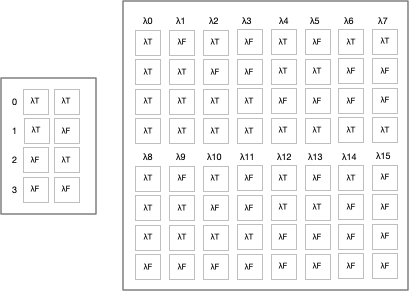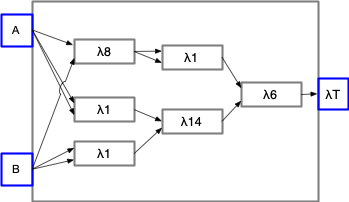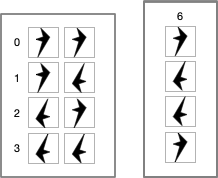Dialog with Jeff Williams: Part III
This is the third part to the answer of his question:
I would ask you to demonstrate why reason is an atomic arrangement, and why it being a part of nature would imply truth; and along with that how you would explain erroneous ideas and the limits of the invariability principles.
The answer will consist of five parts:
- The road to logic
- The road to truth
- Logic and Reason
- The road to meaning
- The road to math
This post will cover the third topic, Logic and Reason.
Logic and Reason
Logic
In the previous post we developed a purely mechanical notion of "truth", where "truth" arbitrarily selects between one of two paths. In this view, "truth" is a behavior - not a value1. This is critical, because we haven't established any values yet. There are just meaningless symbols being combined and selected in mechanical ways.
We showed that if "truth" is the behavior that selects one input and "false" is the behavior that selects the other input (labelled λT and λF) then these behaviors can be combined in four ways resulting in sixteen possible outputs. We showed that each of these sixteen possible outputs are simply chains of λT and λF. For reference, the table is repeated here:

This table should look familiar to anyone who is familiar with classical logic. λ14 is the logical AND operation, that is, TRUE and TRUE is TRUE; everything else is FALSE. The rational for this is typically presented as "it's obvious," but you now know the physical basis for this result. λ8 is the logical OR operation. λ2 is the logical IMPLICATION operation. The names of all 16 operations are given in footnote [2].
Let us consider DeMorgan's Rules:
NOT (A OR B) = (NOT A )AND (NOT B)
NOT (A AND B) = (NOT A) OR (NOT B)
Granted, we are jumping ahead of ourselves. We don't have symbols (except for "lefty" and "righty"), so we don't yet have justification for using "A" and "B". Because we don't have symbols, we don't have values, and because we don't have values, we don't have substitution (i.e. "now set A to λT and B to λF and evaluate the expression"). All of that will come later.
But what we can do is draw the physical network that corresponds to these expressions. We are missing the physical construction for "NOT". "NOT" is a combinator of one input that flips the glyph. NOT "lefty" is "righty"; NOT "righty" is "lefty." So we can add a device that does this, or we can just use the existing combinator 1 -- the NAND gate -- since NAND'ing the input with itself flips the input. (NAND "lefty" "lefty") results in "righty". The network for the first of DeMorgan's rules is:

I recommend as an exercise that you create the physical networks for λ8 and λ14 and, with the already diagrammed λ1 and λ6, draw the network for DeMorgan's first rule using only λ1. Do the same thing for DeMorgan's second rule. It's important to experience the complexity of what nature is doing. We have ways of taming this complexity, but the more we hide it, the more ephemeral the connection to the physical world becomes. It's easy for it to vanish entirely from our sight, especially for a device as complex as the human brain, whose complexity we've barely begun to understand.
With three of these sixteen operations we can now show Aristotle's famous syllogism:
"All men are mortal. Socrates is a man. Therefore, Socrates is mortal."
We translate this into logical implication, which is the way we express "if ... then..." statements. "If man then mortal" is (man -> mortal). "If Socrates then man" is (Socrates -> man). The full syllogism is:
((man -> mortal) AND (Socrates -> man)) -> (Socrates is mortal)
If "man" has two values, λT and λF; and "mortal" has two values, and "Socrates" has two values, then there are 8 possible input combinations. You can verify that the expression evaluates to λT for each of the 8 input combinations, so that it is always true.
DeMorgan's Rules and Aristotle's syllogism are objectively true for two reasons: regardless of the combinations of λT and λF of the input, λT is always output. Furthermore, these operations are based on physical transformations of physical motion through physical networks. It's how nature works. I can't communicate this to my dog, and I likely can't communicate this to a dolphin, but I could communicate this to being from a star-faring race assuming we could share pictures.3
Consider the syllogism:
All white things are sweet. Salt is white. Therefore salt is sweet.
This has the exact same logical form as Aristotle's syllogism:
((white -> sweet) AND (salt -> white)) -> (salt -> sweet)
Because it is the same logical form, it is also always logically true, but I still remember my father's face over 50 years ago when I replaced the sugar in the sugar bowl with salt and he put it in his coffee.
So we now have the case where something can be objectively logically true yet false to experience!4 There are two things happening here. The first is that the output of atoms through gates, in a network constructed a certain way, always outputs "true" (which is, remember, the behavior to select a certain path). Logic only "cares" about form. It only "cares" that the inputs are λT and λF, not how those values are first obtained. This is why there is a "Platonic" world, detached from experience. The other thing happening is mapping of the description "all white things are sweet" to an input. To logic, that's just an input. To us, that's a description of an experience that is false to fact. We haven't yet developed the mechanisms for analyzing this in detail, but what can be said is that this relies on the ability to mis-identify objects.
What is the mechanism for identifying objects? Refer back to combinator 6:

Instead of outputting a glyph, we output a combination device:

This establishes a relationship between the ability to distinguish glyphs with truth. If two glyphs are the same, then the λT selector is used, which chooses the top input network. If two glyphs are different, then the λF selector is used, which chooses the bottom input of the network. So truth can be based on the ability of nature to recognize, if not itself, at least parts of itself. Like charges repel, unlike charges attract. Atoms have valence shells which allow other atoms to combine or not combine. But if truth is the ability to correctly distinguish between objects, not-truth is the ability to misidentify objects. Just substitute λT and λF in the above diagram in any of the sixteen possible ways.
Reason
The "laws of thought" are considered to be:
- The law of identity
- The law of non-contradiction, and
- The law of the excluded middle
Because these identities are fixed, "lefty" cannot be "lefty" and "righty" at the same time. Quantum mechanics allows states to be in superposition, but when a measurement is made, the superposition collapses.
The combinators use "lefty" or "righty". They don't use "uppy" or "downy".5
Observations
- Objective truth exists and is based on the objective ability of nature to distinguish objects, e.g. positive and negative charge. Identity is more basic than life (since charge existed before living things).
- Logic is discovered, not invented.
[1] This is according to the typical view that values are things like numbers and letters. In fact, a behavior can be a value. This is fundamental to how the Lambda Calculus, and therefore, computation, works.
[2] The 16 logical combinations are:
λ0: TRUE X Y - the inputs are ignored and λT
(which is an alias for λ12) is output
λ1: NAND X Y - "NOT AND". NOT flips λT to λF and vice versa.
λ2: IMPLIES X Y - logical implication: if X then Y
λ3: NFIRST X Y - "NOT FIRST", i.e. "NOT X"
λ4: REVIMP X Y - reverse implication: if Y then X
λ5: NSECOND X Y - "NOT SECOND", i.e. "NOT Y"
λ6: EQU X Y - equal
λ7: NOR X Y - "NOT OR"
λ8: OR X Y - logical or
λ9: XOR X Y - logical exclusive or, that is, "NOT EQUAL"
λ10: SECOND X Y - Y
λ11: NREVIMP X Y - NOT reverse implication
λ12: FIRST X Y - X
λ13: NIMPLIES X Y - NOT implication
λ14: AND X Y - logical and
λ15: FALSE X Y - λ10
[3] Also assuming that it didn't eat me, first.
[4] This is why most arguments for/against the existence God are a waste of time. They have a form that is logically true, but the connection to experience is tenuous, at best.
[5] The Lambda Calculus isn't limited to an "alphabet" of two symbols. It can use any number if symbols, as long as they are distinguishable. But the laws of thought can then extend this to a larger alphabet.

